~ ~ ~
The most delightful resort of the Western Hemisphere
From 1881 to the turn of the 20th century, Napa Soda Springs hosted the elites of San Francisco and beyond. The conception of Colonel John Putnam Jackson, the resort epitomized the fine life, California-style. Situated above the Napa Valley in the eastern hills, it presented a Victorian world at its most pleasant. It remains now as forest-covered ruins, as obscure as its history. Though a common feature of documents and books of the time, more modern writers of California histories seem oblivious of the once-famous Soda Springs. It might well have never existed.

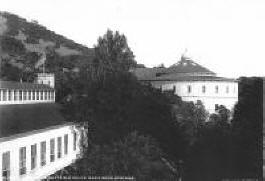
This shows the Rotunda with the upper Napa Valley in the distance.
The vistas from Soda Springs begged belief; looking south you could see
all the way to San Francsisco, with the towns of Napa and Vallejo visible,
as well as the upper San Pablo Bay. The rest of the resort nestles beneath
the trees to the right of the Rotunda, and a dozen more buildings hide in
the shade along the mountainside. The next photo highlights the building
where they bottled the soda water, with the backside of the Rotunda
beyond. The latter was 120 feet in diameter, and its cupola topped
out at almost 80 feet. It could be seen from much of the valley.
~ ~ ~

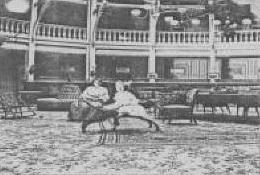
Napans first called the structure "Jackson's Folly," but the Colonel's
vision finally materialized, and the Rotunda claimed the pride of the valley.
It invited the grand entrance after a carriage trip from town in the finest of
rigs, and once inside, guests found themselves dazzled by the expansive interior.
Many of the 50-plus rooms opened onto a mezzanine, and a great chandelier
illuminated the first beautiful people of the Victorian Age.
~ ~ ~

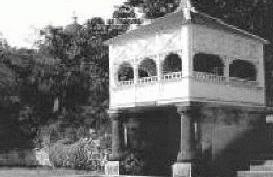
The music conservatory and the Ivy House. Each building at the Springs
was unique, the designs all Colonel Jackson's. They quarried the stone on
the property, and Chinese laborers did the work. The result was a whimsical
pleasure trove, with natural and man-made wonders at hand in every direction.
The Lemon Spring obscures the far more elaborate Pagoda Spring, behind and
above it. The property boasted 27 springs of differing mineral compositions,
and streams, water falls and ponds punctuated the 12 miles of
groomed trails criss-crossing the rugged hills.
~ ~ ~

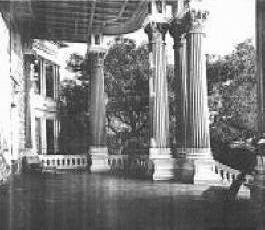
Bellvue and it's porch. Colonel Jackson stayed here when he came up from San
Francisco, and so did his good friend, President Benjamin Harrison. The edifice
angles toward the southern view of the spreading valley as it opens onto the upper
bay. To say that the vistas are breathtaking is surely a cliche, but it was never
more justified in usage. Those columns are replicas of a series commissioned by
Thomas Jefferson for Washington D.C. They feature corn husks on the capitals
instead of acanthus leaves, a specifically American touch.
~ ~ ~

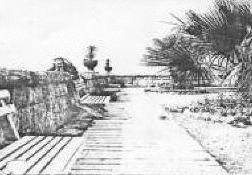
The Dining Room featured the finest food in America except for San Francisco,
and after dinner guests danced and strolled in the moonlight. Benches at overlooks
and within hidden bowers encouraged romantic ardor, and local papers felt compelled
to warn would-be lovers that indiscreet whisperings carried far on the evening air.
~ ~ ~